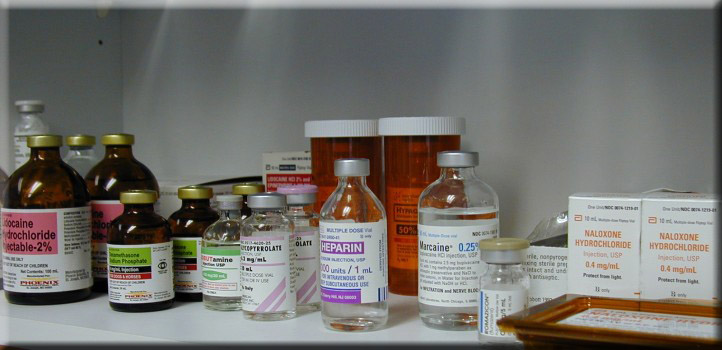 |
Veterinary Anesthesia & Analgesia Support Group |
| Practical Information for the Compassionate Veterinary Practitioner |
|
| HOME |
 |
||
|
|
||
| Alphabetical Drug Summaries | ||
| Dr. Bob Stein | ||
1) EPINEPHRINE
a) Classification
i) Endogenous adrenergic agent with Alpha and Beta properties causing increased contractility and increased blood pressure b) General Information
i) An emergency medication c) Advantages/Recommended use
i) Anaphylactic allergic reactions ii) Cardiac resuscitation (asystole) d) Cautionary Information
i) Store in refrigerator e) Dosage Information
i) Dogs (1) Cardiac resuscitation - 1 ml per 10 kg (20 lb) IV (1:1000 dilution) (2) Anaphylaxis – 0.010 to 0.20 mg/kg (0.005 to 0.10 mg/lb) IV ii) Cats (1) Cardiac Resuscitation - 1 ml per 10 kg (20 lb) IV (1:1000 dilution) (2) Anaphylaxis – 0.010 to 0.20 mg/kg (0.005 to 0.10 mg/lb) IV (3) Feline asthma - 0.1 ml SQ or IV (1:1000 dilution) f) Cost
i) Very low 2) ETODOLAC
a) Classification
i) A COX2 selective NSAID b) General Information
i) Effective anti-inflammatory/analgesic generally free of significant GI side effects c) Advantages/Recommended use
i) Short term use for acute pain ii) Long term use in chronic pain for tolerant patients d) Cautionary Information
i) As with any NSAID, GI side-effects can be substantial (1) Discontinue use if GI signs develop ii) Avoid use in: (1) Combination with corticosteroids (a) Potentially increased ulcerogenic effect (2) Renal compromised patients, dehydrated or hypotensive patients, patients with hepatic disease, pregnancy, patients with pre-existing GI disease, coagulopathies iii) Monitor liver enzymes of canine patients on chronic therapy e) Dosage Information
i) Dogs – 10 to 15 mg/kg (4.8 TO 6.8 mg/lb) PO SID ii) Cats – use of etodolac is not recommended at this time f) Cost
i) Moderately low
3) ETOMIDATE
a) Classification
i) An imidazole
b) General Information
i) Considered the best induction agent for dilated cardiomyopathy ii) Comes in two forms (1) Propylene glycol based USA product - Amidate and generics (2) Hyperlipid emulsion product available in many countries similar to propofol - Etomidate-Lipuro c) Advantages/Recommended use
i) For serious cardiac cases including cardiomyopathy cases d) Cautionary Information
i) May cause myoclonus, retching, or excitement during induction or recovery – this is uncommon if patient is adequately sedate from the premeds or is clinically depressed (1) Premed with one of the following: (a) Oxymorphone 0.05 mg/kg (0.025 mg/lb) IM and midazolam 0.1 mg/kg (0.05 mg/lb) IM (b) Hydromorphone 0.1 mg/kg (0.05 mg/lb) IM and midazolam 0.1 mg/kg (0.05 mg/lb) IM (c) Butorphanol 0.2 mg/kg (0.1 mg/lb) IM and midazolam 0.1 mg/kg (0.05 mg/lb) IM ii) Does suppress adrenocortical function for 3 hours after administration (1) This effect can be overcome by corticosteroid administration if there is an existing adrenal concern (a) Some believe this lack of a “stress response” may actually reduce patient morbidity iii) The propylene glycol containing etomidate can trigger hemolysis that some consider a potential for renal stress (1) Effect of possible pigment overload (2) For renal or anemic patients use etomidate-lipuro iv) Unused etomidate-lipuro should be discarded if not used that day e) Dosage Information
i) Routine induction
(1) Dogs - 0.5 to 3.0 mg/kg (0.25 to 1.5 mg/lb) IV (a) If patient is not already depressed or is not reasonably sedate from premeds, precede etomidate with 0.2 to 0.4 mg/kg (0.1 to 0.2 mg/lb) diazepam IV (2) Cats – 0.5 to 2.0 mg/kg (0.25 to 1.0 mg/lb) IV (a) If patient is not already depressed or is not reasonably sedate from premeds, precede etomidate with 0.2 to 0.4 mg/kg (0.1 to 0.2 mg/lb) diazepam IV ii) Give the propylene glycol containing etomidate with IV fluids to minimize pain on injection and hemolysis (1) This concern is due to the propylene glycol content of this preparation f) Cost
i) Very high |
||
| Return to top of page | ||
| Questions or problems regarding this web site should be directed to DRSTEIN@VASG.ORG . Copyright © 2003 ASAH. All rights reserved. Last modified: February 16, 2011 . |
||